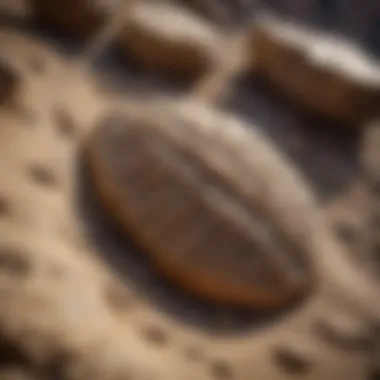Unlocking the Enigma of Sedimentary Rocks: A Comprehensive Guide for Rock Enthusiasts


Rock and Fossil Identification
Understanding sedimentary rocks involves recognizing their distinct types and features. In the world of geology, sedimentary rocks are categorized based on their composition and formation processes. By examining the various sedimentary rocks and fossils, enthusiasts can identify key characteristics that differentiate them from other rock types. Utilizing specialized tools such as magnifying glasses, rock hammers, and flashlights can aid in the accurate identification of these intriguing geological specimens.
Collecting Tips and Techniques
For aspiring rock and fossil collectors, adopting best practices is essential in navigating the rewarding yet nuanced world of sedimentary rocks. Locating prime collecting sites often involves exploring areas with diverse geological formations, such as riverbanks, quarries, and coastal cliffs. Extracting specimens safely requires delicacy and precision to avoid damaging the intricacies of these geological artifacts, utilizing tools like chisels, brushes, and protective gear.
Preservation and Display
Preserving sedimentary rocks and fossils is vital in maintaining their integrity for future study and appreciation. Techniques like cleaning with soft brushes, sealing specimens in airtight containers, and storing them away from direct sunlight can prevent deterioration over time. When it comes to creative display ideas, enthusiasts can showcase their collection using specialized stands, shadow boxes, or even interactive digital platforms to share their passion with others.
Geological Insights
Delving into the geological aspects of sedimentary rocks unveils a world of historical significance and scientific intrigue. By studying the formations and processes that led to the creation of sedimentary rocks, enthusiasts can gain profound insights into the Earth's past environments and evolution. Exploring notable discoveries in the field offers a glimpse into groundbreaking research that enhances our understanding of geology and paleontology.
Introduction
In the vast realm of geology, sedimentary rocks stand as a cornerstone of understanding Earth's history and processes, making it a compelling subject for exploration. This article serves as a beacon for rock and fossil enthusiasts, guiding them through the intricate world of sedimentary rocks with precision. By shedding light on the formation intricacies and key characteristics, readers are primed to immerse themselves in a journey of discovery and comprehension that goes beyond the superficial layers. With a focus on meticulous details and thorough analysis, this comprehensive guide aims to unveil the mysteries encapsulated within sedimentary rocks.
Overview of Sedimentary Rocks
Definition and Formation
Delving into the core of sedimentary rocks unveils a world of sediment accumulation and lithification, where meticulous processes shape and transform sediments over time. The essence of sedimentary rocks lies in their formation from the deposition of mineral and organic particles in various environments, ultimately compressing into solid rock. This foundational aspect serves as a fundamental building block in geology studies, allowing enthusiasts to decipher the intricate layers of Earth's past with each sediment fragment. The allure of understanding sedimentary rock formation lies in its ability to provide a tangible link to bygone eras, showcasing the dynamic evolution of Earth's surface.
Importance in Geology
The significance of sedimentary rocks in geology extends far beyond their physical presence, playing a pivotal role in deciphering geological timelines and environmental shifts. Widely recognized for their stratigraphic value, sedimentary rocks provide a chronological canvas for geologists to interpret and unravel Earth's history layer by layer. By meticulously studying the composition and structure of sedimentary rocks, researchers gain invaluable insights into past climates, depositional environments, and the evolution of flora and fauna. This segment holds a key position in the geologist's toolkit, acting as a portal to unraveling the mysteries hidden within the Earth's rocky archives.
Significance of Identifying Sedimentary Rocks
Understanding Earth's History


Embarking on the journey of identifying sedimentary rocks opens doorways to the annals of Earth's memoirs, revealing tales of ancient landscapes and climatic shifts. Each sedimentary layer carries a narrative of environmental conditions, biological communities, and tectonic events, providing a window into the past that transcends millennia. By decoding the subtle nuances embedded within sedimentary rocks, enthusiasts can reconstruct past ecosystems, understand sediment transport dynamics, and trace the evolutionary paths of Earth's inhabitants. This facet of identifying sedimentary rocks serves as a time machine, propelling individuals back through the annals of time to witness the vibrant tapestry of Earth's history.
Determining Depositional Environments
Unraveling the clues embedded within sedimentary rocks enables researchers to pinpoint the precise environments in which sediments were laid down, offering insights into ancient landscapes and geodynamic processes. By scrutinizing sedimentary structures and fossil assemblages, geologists can decipher the depositional settings, ranging from marine shelves to continental deltas, each unveiling a unique chapter of Earth's ever-evolving story. This investigative process not only unveils the intricate interplay between sedimentary patterns and environmental conditions but also illuminates the dynamic relationships between Earth's crustal movements and sediment deposition. Through the identification of depositional environments, enthusiasts gain a profound understanding of the dynamic processes that have sculpted our planet over eons.
Physical Characteristics
Sedimentary rocks possess distinct physical characteristics that play a pivotal role in their identification and interpretation. Understanding the granular composition, texture, color, and layering patterns is crucial in unraveling the geological history encapsulated within these rocks. By scrutinizing the physical traits of sedimentary rocks, geologists can discern critical information about their formation processes, environmental conditions during deposition, and potential tectonic influences. These elements serve as the building blocks for decoding the intricate narrative written in stone.
Grain Size and Texture
Microscopic Analysis
Grain size and texture, as observed through microscopic analysis, offer invaluable insights into the depositional history and environmental conditions surrounding sedimentary rock formation. By closely examining the fine details of mineral grains under a microscope, geologists can determine the sediment source, transportation mechanism, and potentially even the climate prevalent during deposition. Microscopic analysis provides a nuanced perspective on the intricate relationships between various mineral components, aiding in the classification and interpretation of sedimentary rocks.
Macroscopic Observation
Macroscopic observation of grain size and texture facilitates a macro-level understanding of sedimentary rocks, enabling geologists to discern patterns, structures, and variations at a visible scale. By visually scanning the rock surface, distinguishing between different grain sizes, shapes, and arrangements becomes feasible, shedding light on the sedimentary processes at play. This observational approach offers a broader view of sedimentary rock characteristics, complementing the detailed insights gleaned from microscopic analysis.
Composition and Color
Mineral Content
The mineral content of sedimentary rocks is a defining feature that dictates their physical properties, coloration, and overall composition. By analyzing the mineral assemblage present within these rocks, geologists can infer the rock's origin, metamorphic history, and the prevailing geological conditions during formation. Understanding the mineral content provides essential clues about the depositional environment and the tectonic forces shaping the sedimentary sequences, enriching the geologic interpretation.
Variations in Coloration
Color variations in sedimentary rocks reflect the diverse mineral compositions and environmental conditions that influenced their formation. The different hues and shades present in sedimentary strata offer crucial evidence regarding fluctuating sediment sources, diagenetic alterations, and potential depositional settings. Observing these color variations aids geologists in deciphering changes in sediment supply, depositional energy, and diagenetic processes, enhancing the comprehensive analysis of sedimentary sequences.
Layering and Bedding
Distinctive Patterns


Layering and bedding patterns in sedimentary rocks exhibit distinct arrangements that provide significant clues about the depositional history and sedimentary processes involved. The stratigraphic sequences and bedding structures delineate temporal changes, variations in energy conditions, and sediment accumulation rates over time. These distinctive patterns offer a chronological record of deposition, enabling geologists to reconstruct past environments and interpret the geological events that shaped the sedimentary layers.
Interpretation of Sedimentation
Understanding the mechanisms of sedimentation through the interpretation of bedding structures is vital for unraveling the depositional environments and reconstructing the paleogeographic settings of sedimentary rocks. By analyzing the orientations, thicknesses, and relationships between different beds, geologists can infer the dynamics of sediment transport, rates of deposition, and potential tectonic influences. Interpreting sedimentation patterns provides critical insights into the sediment sources, basin dynamics, and paleoenvironmental conditions, contributing to a holistic understanding of sedimentary rock formation.
Structural Features
Fossils and Imprints
Types of Fossils Found
Fossils and imprints play a crucial role in unraveling the mysteries hidden within sedimentary rocks. The types of fossils found in sedimentary formations offer invaluable insights into past life forms and environments. By examining these fossils, researchers can piece together the puzzle of geological history and evolution. The identification and study of these fossils contribute significantly to the overarching goal of understanding Earth's intricate past.
Paleontological Significance
The paleontological significance of fossils found in sedimentary rocks cannot be overstated. These fossils provide direct evidence of ancient life on Earth, offering a window into ecosystems of bygone eras. By analyzing these fossils, scientists can infer evolutionary trends, climatic conditions, and even past environmental catastrophes. The study of paleontological remains enhances our understanding of the planet's dynamic history and the interplay between geology and biology.
Sedimentary Structures
Cross-Bedding
Cross-bedding represents a fundamental aspect of sedimentary structures, indicative of past depositional environments and sediment transport processes. The distinct pattern of inclined layers within rock strata reveals information about flow dynamics and directional changes in ancient currents. Understanding cross-bedding aids geologists in reconstructing the original orientation of sedimentary deposits and deciphering ancient sedimentary environments based on the spatial arrangement of these structures.
Ripple Marks
Ripple marks, another significant sedimentary structure, offer valuable clues about ancient water bodies and geological conditions. These wave-like textures preserved in rocks indicate the presence of former water currents, whether in marine or terrestrial environments. By studying ripple marks, geologists can infer the flow direction, intensity, and the nature of the depositional environment. Ripple marks serve as a time capsule, capturing dynamic processes that have shaped Earth's surface over millions of years.
Section Four: Diagnostic Tests
In this section, we will delve into the crucial aspect of Diagnostic Tests within the realm of sedimentary rocks. Understanding the importance of Diagnostic Tests is paramount in the comprehensive identification and analysis of sedimentary rocks. These tests serve as key tools for geologists, rock collectors, and enthusiasts in deciphering the composition and characteristics of sedimentary formations. By focusing on specific elements such as acid reactions and fossil examinations, Diagnostic Tests play a vital role in shedding light on the geological history encapsulated within sedimentary rocks.
Acid Reaction


Calcite Presence Test
The Calcite Presence Test stands as a fundamental component of Diagnostic Tests in sedimentary rock analysis. This test revolves around the chemical behavior of calcite when subjected to acidic substances. The identification of calcite within sedimentary rocks signifies the presence of carbonates, offering valuable insights into the depositional environments and geological processes involved. The key characteristic of the Calcite Presence Test lies in its ability to distinguish between calcite-rich and calcite-poor sediments, aiding in the interpretation of rock formations. It is a favored choice in sedimentary rock studies due to its reliability in differentiating carbonate-rich layers, contributing significantly to the overall analysis conducted in this article. The unique feature of the Calcite Presence Test lies in its simplicity yet effectiveness in determining the carbonate content of sedimentary rocks, although its limitations may arise in cases of mixed mineral compositions or intricate geological settings.
Dolomite Reaction
On the other hand, the Dolomite Reaction test focuses on unraveling the presence of dolomite in sedimentary rocks. This test elucidates the reactivity of dolomite when exposed to acids, providing crucial information on the mineralogical composition of the rocks under scrutiny. The key characteristic of the Dolomite Reaction test lies in its ability to differentiate between calcite and dolomite content, aiding in the accurate identification and classification of sedimentary formations. It is a popular choice in this article due to its significance in distinguishing between carbonate minerals and enhancing the understanding of sedimentary rock evolution. The unique feature of the Dolomite Reaction test lies in its capacity to unveil the presence of dolomite, a valuable insight for interpreting the geological history encapsulated within sedimentary rocks. While advantageous in many scenarios, limitations of this test may arise in cases where dolomite content is minimal or obscured by other mineral components.
Fossil Examination
Fossil Examination constitutes another essential aspect of Diagnostic Tests within the study of sedimentary rocks. This segment focuses on the meticulous analysis of fossils found within sedimentary formations, unravelling the paleontological significance embedded within these rocks. The identification process involved in Fossil Examination aids in recognizing and categorizing the types of fossils present, shedding light on the ancient organisms that once inhabited the Earth. It is a beneficial choice for this article as it contributes to establishing the age and depositional conditions of sedimentary rocks. The unique feature of the Identification Process lies in its ability to discern fossil types and link them to specific geological eras, enriching the overall understanding of sedimentary rock formations and their historical context.
Age Determination
Conversely, Age Determination plays a critical role in deciphering the temporal aspects of sedimentary rocks. This test revolves around determining the age of sedimentary formations through various dating techniques, offering valuable insights into the timeline and evolution of geological events. The key characteristic of Age Determination lies in its capacity to provide numerical or relative age estimates, aiding in constructing a chronological framework for the sedimentary sequences under examination. It is a popular choice in this article due to its significance in pinpointing the temporal context of sedimentary rocks and correlating them with geological events. The unique feature of Age Determination lies in its ability to refine the chronological interpretations of sedimentary sequences, providing a deeper understanding of the Earth's history encoded within these rocks. However, challenges may arise in cases where dating methods yield ambiguous results or when the sedimentary record is complex, necessitating further analysis and consideration.
Interpreting Environments
In this 5th section of the article, we delve into the crucial aspect of interpreting environments when studying sedimentary rocks. Understanding the depositional settings of sediments provides vital insights into the Earth's history and geological processes. By analyzing the environmental conditions under which sediments accumulate, researchers can trace back the sequence of events that shaped the landscape over time. This section serves as a key link between the physical characteristics of sedimentary rocks and the broader context of their formation, offering enthusiasts a holistic perspective on Earth's dynamic past.
Depositional Settings
Marine Environments
Exploring marine environments in the context of sedimentary rock formation reveals a wealth of information about past oceans and seas. The distinctive feature of marine environments lies in the presence of marine organisms, whose remains contribute significantly to the composition of sedimentary rocks. Fossils found in marine sediments offer valuable clues about ancient marine life and ecosystem dynamics. The marine setting also showcases variances in sediment type and structure, reflecting the diverse depositional conditions present in oceans and seas. Studying marine environments proves crucial for understanding how oceans have evolved and influenced the formation of sedimentary rocks throughout geological history.
Fluvial Systems
Investigating fluvial systems as a depositional setting sheds light on the role of rivers and streams in sediment transport and deposition. The key characteristic of fluvial systems lies in their ability to transport sediments over varying distances, creating distinctive sedimentary features like gravel bars, sand dunes, and floodplains. Fluvial environments are favored for their dynamic nature, constantly reshaping the landscape through erosion and sedimentation. The unique feature of fluvial systems is their sensitivity to climatic and tectonic influences, making them valuable indicators of past environmental changes. Delving into fluvial systems enriches the understanding of how terrestrial processes contribute to the formation of sedimentary rocks, offering a glimpse into Earth's ever-changing surface.
Tectonic Influence
Impact on Rock Formation
Examining the impact of tectonics on rock formation uncovers the significance of geological forces in shaping the Earth's crust. Tectonic activity plays a crucial role in the deformation and uplift of sedimentary rocks, creating mountain ranges, basins, and other landforms. The key characteristic of tectonic influence is its ability to modify existing rock structures through folding, faulting, and metamorphism, leading to the formation of diverse sedimentary features. The unique feature of tectonic influence lies in its long-term impact on sedimentary rocks, reflecting the tectonic history of a region through distinctive rock structures and orientations. Understanding the tectonic influences on rock formation offers valuable insights into the dynamic processes that have sculpted the Earth's lithosphere over millions of years.
Structural Deformation
Exploring structural deformation as a result of tectonic forces elucidates the complexities of rock deformation and strain. The key characteristic of structural deformation is the alteration of rock layers through folding, faulting, and shearing, showcasing the intense pressures exerted by tectonic movements. Structural deformation contributes to the formation of anticlines, synclines, and other structural features that reveal the tectonic history of a region. The unique feature of structural deformation is its role in generating mountain belts, rift valleys, and other large-scale geological structures, offering a glimpse into the dynamic processes at work beneath the Earth's surface. Delving into structural deformation provides enthusiasts with a deeper appreciation for the forces driving rock deformation and the intricate interplay between tectonics and sedimentary rock formation.







